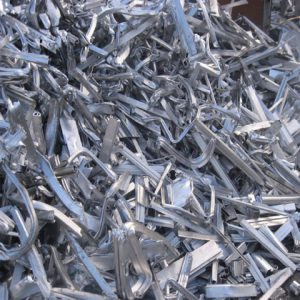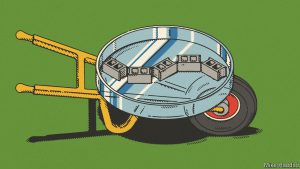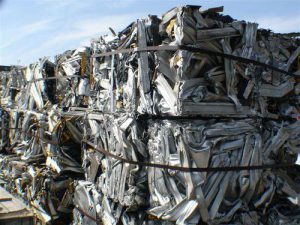
Did you know that some of the junk sitting in your garage could end up making you some money and help save the environment? Maybe you’ve already heard about selling scrap metal and you just haven’t gotten to it yet, or maybe the process seemed too complicated to follow through.
Either way, it isn’t too late to start recycling your scrap metal and make some extra money. Keep reading this guide to learn about the basics of selling scrap metal, as well as common sources of aluminum scrap and what to do with it.
What is Scrap Metal?
Scrap metals are recyclable materials that were either leftover from production or the parts of something that have already served their purpose. These metals are often mistaken for waste and thrown away without a second thought. However, scrap metals can be recycled and provide several benefits to you and the environment.
Types of Scrap Metal
Before bringing in your metal to scrap it, it’s important to separate your metals based on if they’re ferrous or non-ferrous. Ferrous materials are metals that are magnetic; they typically don’t go for as much money at scrap yards as non-ferrous materials, but they’re still worth recycling. Non-ferrous materials are metals that are not magnetic.
Even though our guide is going to be primarily focused on the different types of aluminum scrap, knowing what the other types of scrap metal are can help you too.
- Aluminum is a non-ferrous metal that you can identify by its shiny appearance and soft, flexible qualities.
- Brass is a non-ferrous metal that can be identified by its similar appearance to yellow gold; it is a very durable metal.
- Carbide is a non-ferrous metal that is made up of carbon and tungsten; it is a durable metal often used at the ends of tools due to its resistance to heat, scratches, and rust.
- Copper is a non-ferrous metal that you can identify by its red or pink color; it is soft, malleable, and makes a great conductor for electricity.
- Iron is a ferrous metal that can be identified by its magnetism and dull grey or rusty color. Iron comes in different forms, some are malleable and soft while others are brittle.
- Lead is a non-ferrous metal that is varying shades of grey and very heavy. Despite its weight, it’s soft and malleable.
- Steel is a ferrous metal that is easy to identify by its silver color, magnetism, and heavyweight.
- Titanium is a non-ferrous metal that is a bit more difficult to identify. It is a very strong yet lightweight material that is often silver in color.
If you have scrap metal that you’re unable to identify, this guide is a very helpful resource for determining what metals you have. The most important thing to do is sort your metals by if they’re magnetic or not, as long as you can do that scrap yards will be able to identify the rest for you.
Benefits of Recycling Scrap Metal
Many people like to recycle their scrap metal to make some extra cash for stuff that they no longer need.
Aside from making some extra money, recycling your scrap metal has several benefits that you may not be aware of. Learning about these benefits will help you make a better decision on what to do with any scrap metal you find lying around your house.
Reduces Mining
Mining is very harmful to the environment. It not only destroys the soil but also puts toxic materials into water and air. Aside from the contamination of soil and water, mining destroys the homes of the wildlife in that area, leaving animals with nowhere to go.
While there will always be a need for mining, recycling your scrap metals can significantly reduce the need for it. The less mining there is, the less we negatively impact the environment, which is always a step in the right direction. Every little bit makes a difference.
Saves Energy
Metal processing plants use up a lot of energy, especially when they’re processing raw metals. Recycled metals significantly decrease the amount of energy needed to process into something new. The amount of energy that is saved just from recycling steel is equivalent to the energy needed to power about 20% of the households in America for a whole year.
Boosts the Economy
Recycling scrap metal doesn’t just make you money, but it also helps boost our economy. The metal recycling industry plays a pretty important role in this country. According to the Institute of Scrap Recycling Industries, In 2019 the United States exported $10.6 billion worth of just non-ferrous metals to other countries!
Common Sources of Aluminum Scrap and What to Do With it
Now that you’re familiar with the different types of scrap metal and why it’s important to recycle them, we’ll go over some common sources of aluminum and what you can do with it. When you recycle aluminum, it reserves 80% of the energy needed to process new aluminum. That’s a big difference that you can make just by recycling!
Aluminum Cans
One of the most common sources of aluminum is aluminum cans. These cans that once held your soda, beer, and even food are all recyclable. Before bringing them to a scrapyard, be sure to rinse them clean and crush them if you’re able to.
Aluminum Siding and Gutters
If you find yourself renovating the exterior of your house, you may have plenty of scrap aluminum from your siding and gutters. Before bringing your aluminum siding to a scrap yard, be sure to scrape off any insulation that may still be on it.
Aluminum Wiring
When you’re sorting through cables and wires you might be surprised to find out that many of them are made of aluminum and not copper. A good way to determine what your wires are made of is to check the color, and if they’re silver, they’re aluminum.
Aluminum Bicycles
Lots of old bicycles have frames made from aluminum! If you’re no longer getting any use from your aluminum bike, recycling is a good way to go. Just make sure to remove the handlebars and tires before you bring it to the scrap yard.
Aluminum Rims
The rims on most vehicles today are made from aluminum because of how lightweight they are and their heat resistance. These can be brought to a scrap yard but may not fetch as high of a price if they’re dirty. Be sure to scrape off any rubber or lead that may still be on them before bringing them to a scrapyard.
Sheet Aluminum
Sheet aluminum is widely used in objects all around us, so it’s hard to specify one thing that it comes from. Some examples of sheet aluminum include the bodies of some vehicles, license plates, parts of cookware, and more. If you’re done using something that has sheet metal in it, it could be worth separating and bringing to your local scrap yard to recycle.
Link: https://salvage.jksalvageco.com/materials/common-sources-of-aluminum-scrap-and-what-to-do-with-it/





